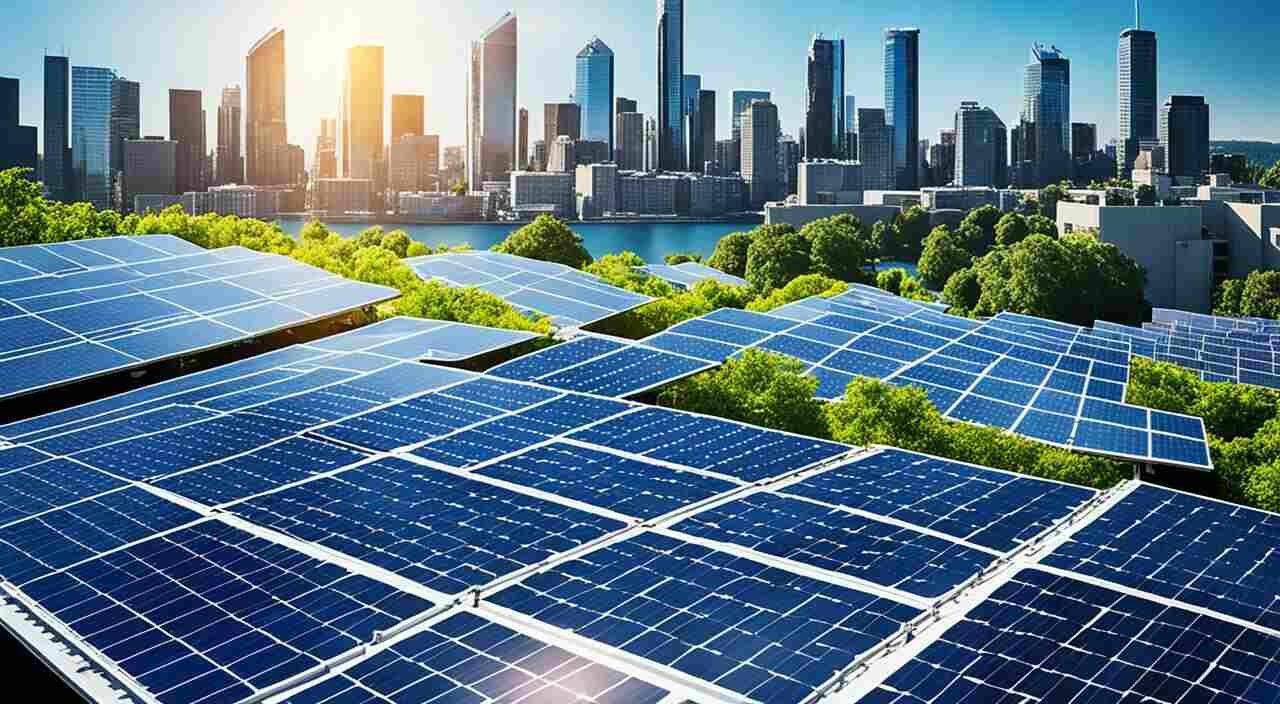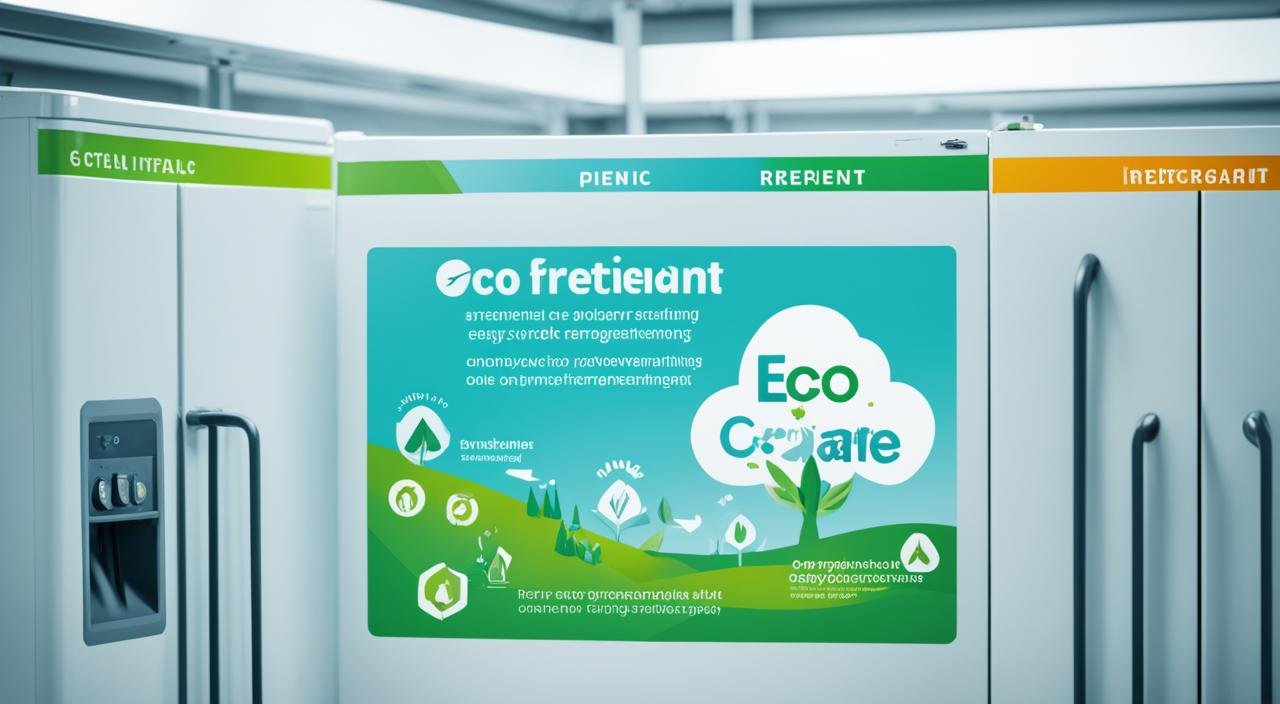Building an eco-friendly home is becoming increasingly popular as homeowners look for ways to live sustainably. By choosing green house plans, you can reduce your carbon footprint and promote energy efficiency. These plans are designed to prioritize environmental responsibility while still offering style and comfort. Let’s explore some of the key features and benefits of eco-friendly green house plans.
Key Takeaways:
- Eco-friendly house plans help reduce your carbon footprint and promote energy efficiency.
- Green house plans offer environmental responsibility without compromising style or comfort.
- Choosing sustainable house plans can lead to long-term cost savings on utility bills.
- Green home designs prioritize features like natural daylighting and insulation for energy efficiency.
- By selecting eco-friendly house plans, you can create a sustainable living space that aligns with your values.
ENERGY STAR House Plans for Maximum Efficiency
When it comes to building an eco-friendly home, ENERGY STAR-rated house plans are an excellent choice for maximizing energy efficiency and reducing utility costs. These specially designed plans have been optimized to minimize energy consumption while still providing the same level of functionality and comfort as traditional homes. By selecting an ENERGY STAR house plan, you can enjoy significant savings on your utility bills and contribute to a more sustainable future.
One of the key benefits of ENERGY STAR house plans is their ability to reduce utility costs by 20 to 30% compared to conventional homes. With rising energy prices, the savings obtained from these energy-efficient house plans can make a significant difference in your monthly expenses. Whether it’s cooling in the summer or heating in the winter, choosing an ENERGY STAR house plan will help you maintain a comfortable living environment without breaking the bank.
With a focus on energy efficiency, ENERGY STAR house plans incorporate various features and technologies that contribute to reduced energy consumption. These may include high-performance windows and insulation, efficient heating and cooling systems, and advanced air sealing. Additionally, the use of energy-efficient appliances and lighting further enhances the overall energy performance of these homes.
By selecting an ENERGY STAR house plan tailored to your geographic location and climate, you can ensure your home is optimized for maximum efficiency. These plans take into account regional climate conditions, allowing you to harness the natural resources available in your area. Whether it’s passive solar heating in colder regions or natural ventilation in warmer regions, ENERGY STAR house plans are designed to make the most of your environment.
Benefits of ENERGY STAR House Plans:
- Significant utility cost savings compared to traditional homes
- Optimized energy efficiency without compromising comfort
- Use of energy-efficient appliances and lighting
- Utilization of natural resources for maximum efficiency
By choosing an ENERGY STAR house plan, you not only benefit from utility cost savings and energy efficiency but also contribute to a more sustainable future. These environmentally friendly homes help reduce greenhouse gas emissions and promote a cleaner, healthier environment for you and future generations.
Next, we will explore the wide range of benefits that green home plans offer, including cost savings, energy-efficient appliances, natural daylighting techniques, and superior insulation. Stay tuned!
The Benefits of Green Home Plans
Green home plans offer numerous benefits for homeowners. Firstly, these plans often save money on construction costs due to their smaller size and compact design. They also incorporate features like extra insulation, energy-efficient water heaters, lighting, and appliances, resulting in lower utility bills. Green house plans pay special attention to window placement and overhangs to control sunlight and utilize natural daylighting techniques. Furthermore, these plans include insulation and wall systems suitable for extreme hot and cold temperatures, minimizing HVAC loads. With green home plans, you can enjoy cost savings and provide a comfortable living space that promotes sustainability.
The Benefits of Green Home Plans
Green home plans offer numerous benefits for homeowners. Firstly, these plans often save money on construction costs due to their smaller size and compact design. They also incorporate features like extra insulation, energy-efficient water heaters, lighting, and appliances, resulting in lower utility bills. Green house plans pay special attention to window placement and overhangs to control sunlight and utilize natural daylighting techniques. Furthermore, these plans include insulation and wall systems suitable for extreme hot and cold temperatures, minimizing HVAC loads. With green home plans, you can enjoy cost savings and provide a comfortable living space that promotes sustainability.
Green home plans offer numerous benefits for homeowners. Firstly, these plans often save money on construction costs due to their smaller size and compact design. They also incorporate features like extra insulation, energy-efficient water heaters, lighting, and appliances, resulting in lower utility bills. Green house plans pay special attention to window placement and overhangs to control sunlight and utilize natural daylighting techniques. Furthermore, these plans include insulation and wall systems suitable for extreme hot and cold temperatures, minimizing HVAC loads. With green home plans, you can enjoy cost savings and provide a comfortable living space that promotes sustainability.
The Benefits of Green Home Plans
Green home plans offer numerous benefits for homeowners:
- Cost savings on construction
- Lower utility bills
These plans incorporate:
- Extra insulation
- Energy-efficient water heaters
- Lighting and appliances
Green house plans also focus on:
- Window placement and overhangs for natural daylighting
- Insulation and wall systems for extreme temperatures
By choosing green home plans, you can enjoy a comfortable living space while promoting sustainability.
The Benefits of Green Home Plans
Green home plans offer numerous advantages that promote sustainable living and cost savings:
| Benefits | Description |
|---|---|
| Lower Construction Costs | Smaller size and compact design reduce construction expenses. |
| Energy Efficiency | Incorporate extra insulation, energy-efficient appliances, and lighting for reduced utility bills. |
| Natural Daylighting | Strategically placed windows and overhangs control sunlight, reducing the need for artificial lighting. |
| Extreme Temperature Comfort | Insulation and wall systems designed for hot and cold climates minimize HVAC usage. |
By choosing green home plans, you can enjoy a comfortable living space that is environmentally friendly and financially advantageous.
Designing for Sustainability
When it comes to creating a sustainable home, incorporating green features is essential. A well-designed sustainable home prioritizes natural lighting, ventilation, and environmentally conscious materials, ensuring a harmonious blend of comfort and eco-friendliness.
To maximize natural lighting, large windows strategically placed throughout the house allow ample sunlight to flood the living spaces. This not only reduces the need for artificial lighting during the day but also enhances the overall ambiance of the home. Additionally, incorporating skylights and light tubes can further optimize natural lighting, reducing energy consumption.
Proper ventilation is crucial for maintaining a healthy and comfortable living environment. By incorporating features like operable windows, cross-ventilation can be achieved, promoting air circulation and reducing the need for mechanical cooling. This not only improves indoor air quality but also minimizes reliance on energy-consuming air conditioning systems.
An integral part of sustainable home design is using environmentally conscious materials. From flooring to countertops, opting for sustainable materials such as bamboo, reclaimed wood, or recycled glass can significantly reduce the ecological footprint of the home. These materials not only contribute to a healthier environment but also add aesthetic appeal.
A compact footprint is another key aspect of sustainable home design. By reducing the home’s overall size and simplifying the exterior walls with fewer corners, construction costs, waste, and energy consumption can all be minimized. This mindful approach not only benefits the environment but also helps homeowners save money in the long run.
Flexibility is crucial for long-term livability. A well-planned floor plan accounts for future growth and changing needs, ensuring that the home can adapt to evolving lifestyles. By incorporating flexible spaces that can serve multiple purposes, such as a home office that can transform into a guest bedroom, homeowners can make the most of their space without the need for extensive renovations.
Passive heating and cooling strategies are another important consideration in sustainable home design. By strategically positioning large windows to take advantage of natural sunlight and well-placed roof overhangs to provide shade when needed, passive solar heating and cooling can be achieved. This reduces the reliance on energy-consuming heating and cooling systems while maintaining a comfortable indoor temperature.
“Incorporating green features into the design of your home ensures that sustainability is at the forefront of your living environment. From maximizing natural lighting and ventilation to utilizing environmentally conscious materials, every design choice has the potential to contribute to a greener future.”
Designing for sustainability is not just about creating an aesthetically pleasing home; it’s about making conscious choices that prioritize the well-being of both the inhabitants and the environment. By integrating green features and thoughtful design, homeowners can create sustainable homes that are both functional and eco-friendly.
Sustainable Home Design Checklist:
- Maximize natural lighting through strategically placed windows, skylights, and light tubes.
- Promote proper ventilation with operable windows and cross-ventilation techniques.
- Use environmentally conscious materials like bamboo, reclaimed wood, and recycled glass.
- Create a compact footprint to reduce construction costs, waste, and energy consumption.
- Incorporate flexible spaces that can adapt to future needs.
- Optimize passive solar heating and cooling through window placement and roof overhangs.
Image: An example of sustainable home design showcasing a well-lit and ventilated living space.
Contemporary-Modern House Plans for Green Living
Embrace eco-friendly living with contemporary-modern house plans. These innovative designs blend sustainability with style, offering a perfect solution for those seeking a green home. Contemporary-modern house plans incorporate unique features that promote energy efficiency and environmental responsibility.
Solar Panels for Renewable Energy
One standout feature of contemporary-modern house plans is their slanted rooflines, which provide an ideal space for solar panels. By harnessing the power of the sun, these homes can generate renewable energy, reducing reliance on traditional energy sources. Solar panels not only help to reduce carbon emissions but also offer long-term savings on electricity bills.
Indoor-Outdoor Living for Sustainable Comfort
Contemporary-modern house plans prioritize indoor-outdoor living, blurring the boundaries between interior and exterior spaces. Large windows and glass walls flood the interiors with natural light, reducing the need for artificial lighting during the day. This design initiative not only enhances the aesthetics of the home but also promotes a connection with nature and reduces reliance on energy-consuming lighting fixtures.
Passive Heating for Energy Efficiency
Another key aspect of contemporary-modern house plans is their focus on passive heating strategies. The abundant windows and open floor plans allow sunlight to penetrate deep into the interior spaces, providing natural warmth during colder months. This reduces the reliance on artificial heating systems and minimizes energy consumption.
“Contemporary-modern house plans combine style with sustainability, offering a visually striking and eco-friendly living experience.”
By choosing a contemporary-modern house plan, you can enjoy the benefits of a green home without compromising on aesthetics or comfort. From solar panels to indoor-outdoor living and passive heating, these designs prioritize sustainable living and energy efficiency. Experience a modern and eco-friendly lifestyle with contemporary-modern house plans.
The Importance of Green Design
Building a sustainable home starts with a green design. By choosing a home plan that incorporates sustainable features, you can create an environmentally friendly and energy-efficient living space. Green design encompasses various elements that contribute to a healthier environment, including:
- Natural Lighting: By maximizing natural light through strategic window placement, you can reduce the need for artificial lighting during the day. This not only saves energy but also creates a warm and inviting atmosphere.
- Ventilation: Proper ventilation ensures fresh air circulation throughout your home, promoting a healthy indoor environment. Incorporating eco-friendly ventilation systems can enhance energy efficiency while maintaining optimal air quality.
- Environmentally Friendly Materials: When selecting materials for your home, opt for sustainable options such as recycled-glass countertops and non-toxic paint. These choices minimize waste, reduce environmental impact, and contribute to a greener future.
Green design also considers value engineering, which focuses on optimizing costs, waste reduction, and labor efficiency. By prioritizing sustainable practices during the design phase, you can reduce construction expenses and environmental harm. Additionally, a well-designed sustainable home eliminates the need for future expansions, minimizing the consumption of materials and energy.
Building a sustainable home is not just about reducing your carbon footprint, but also creating a comfortable and healthier living environment for you and your family. By embracing green design principles and practices, you can enjoy the benefits of sustainable living while contributing to a greener future.
Key Criteria for Green House Plans
When evaluating green house plans, several key criteria should be considered. By focusing on these criteria, you can ensure that the house plan you choose aligns with your goals of sustainability and energy efficiency.
A compact footprint reduces construction material and energy consumption, making the home more affordable and sustainable. Green house plans with a small footprint prioritize efficiency and minimize wasted space. When every square inch is optimized, fewer resources are required during construction, reducing the overall environmental impact.
Flexible spaces are another important consideration. By including bonus rooms that can be used for future expansion or adapting to changing needs, green house plans offer versatility and eliminate the need for a new home. This ensures that your home can accommodate your evolving lifestyle without the need for extensive renovations.
Passive solar heating is a crucial aspect of energy-efficient design. Green house plans utilize large windows and well-placed overhangs to take advantage of natural sunlight, reducing the need for artificial lighting and lowering energy consumption. This passive heating strategy not only saves energy but also creates a more comfortable living environment.
Energy-saving design features are essential for achieving optimal efficiency. Green house plans incorporate insulation, high-performance windows, and energy-efficient appliances to minimize energy waste. By selecting a house plan with these features, you can significantly reduce your energy consumption and lower utility costs.
By carefully considering these key criteria when evaluating green house plans, you can choose a design that aligns with your sustainability goals. Let’s take a look at the following table, which summarizes the important features of green house plans:
| Criteria | Description |
|---|---|
| Compact footprint | Reduces construction material and energy consumption |
| Flexible spaces | Accommodates changing needs and eliminates the need for a new home |
| Passive solar heating | Utilizes large windows and well-placed overhangs for energy-saving heating |
| Energy-saving design | Incorporates insulation, high-performance windows, and energy-efficient appliances |
Choosing a green house plan that embraces these criteria will ensure that your home is environmentally friendly, energy-efficient, and built with sustainability in mind.
Certifying Green Homes
Some green house plans go beyond basic green design principles and include specifications for materials and building practices that allow the home to be certified as green (Certified Green Homes). These plans often showcase photos of finished, certified homes, giving homeowners confidence in their sustainability. By choosing certified green house plans, you can feel assured that your home meets strict standards for environmental responsibility and sustainability.
Green building certification ensures that the construction process and materials used adhere to sustainable practices and prioritize energy efficiency. Building a certified green home not only reduces your carbon footprint but also promotes a healthier living environment. When you choose sustainable materials, you contribute to the conservation of natural resources and support the development of a more sustainable future.
| Benefits of Certifying Green Homes | |
|---|---|
| 1. Energy Efficiency | Certified green homes are designed to maximize energy efficiency, reducing energy consumption and utility costs. |
| 2. Improved Indoor Air Quality | Certified green homes prioritize indoor air quality, utilizing non-toxic materials and effective ventilation systems. |
| 3. Sustainable Materials | Green building certification ensures the use of sustainable materials, reducing the environmental impact during construction and promoting resource conservation. |
| 4. Water Efficiency | Certified green homes incorporate water-efficient fixtures and systems, promoting water conservation and reducing water bills. |
| 5. Long-Term Cost Savings | By investing in a certified green home, you can enjoy long-term cost savings through reduced utility bills and maintenance expenses. |
Conclusion
Building an eco-friendly home begins with selecting the right house plans. Green house plans prioritize energy efficiency, cost savings, and sustainable living. By incorporating features such as natural lighting, energy-efficient appliances, and green building materials, these designs offer a stylish and environmentally responsible living space.
With a wide range of options available, including contemporary-modern designs and ENERGY STAR-rated plans, homeowners can find the perfect eco-friendly house plan to transform their dream home into a sustainable reality. Whether you’re looking to reduce your carbon footprint, save on utility costs, or promote a healthier living environment, eco-friendly house plans provide practical and innovative solutions.
Embracing sustainable living is not only beneficial for the environment but also for your long-term wellbeing. Green architecture combines functionality, aesthetics, and environmental consciousness to create homes that are both comfortable and sustainable. By choosing eco-friendly house plans, you can make a positive impact on the planet while enjoying the benefits of a greener, more energy-efficient home.
FAQ
What are green house plans?
Green house plans are designs that prioritize environmental responsibility and energy efficiency. They incorporate features such as natural lighting, energy-efficient appliances, and green building materials to create a sustainable living space.
How do ENERGY STAR house plans work?
ENERGY STAR house plans are optimized to reduce utility costs by 20 to 30% compared to traditional homes. They achieve maximum efficiency based on location while still offering a variety of styles and sizes to suit your preferences.
What are the benefits of green home plans?
Green home plans offer cost savings on construction costs and utility bills. They incorporate energy-efficient features, such as insulation, lighting, and appliances, and utilize natural daylighting techniques. These plans also provide comfortable living spaces that promote sustainability.
What should be considered when designing for sustainability?
Designing for sustainability involves prioritizing natural lighting, ventilation, and environmentally conscious materials. It also includes a compact footprint, well-planned floor plans, and passive solar heating and cooling strategies.
Why are contemporary-modern house plans suitable for green living?
Contemporary-modern house plans often feature slanted rooflines that accommodate solar panels, promoting renewable energy. They also have large windows and indoor-outdoor living areas, allowing for passive heating and cooling strategies.
How important is green design in building an eco-friendly home?
Green design is crucial in creating a sustainable home. It includes features such as natural lighting, ventilation, recycled-glass countertops, non-toxic paint, and green building practices that prioritize environmental responsibility.
What criteria should be considered when selecting green house plans?
Some key criteria include a compact footprint to reduce construction material and energy consumption, flexible spaces for future expansion, passive solar heating through well-placed windows and overhangs, and energy-saving design features.
Can green homes be certified?
Yes, some green house plans can be certified as environmentally responsible. These plans often specify materials and building practices that meet strict standards for sustainability, giving homeowners confidence in their green homes.
Are eco-friendly house plans a sustainable choice?
Yes, eco-friendly house plans prioritize energy efficiency, cost savings, and sustainable living. By incorporating green features and materials, these designs offer stylish and environmentally responsible living spaces.





